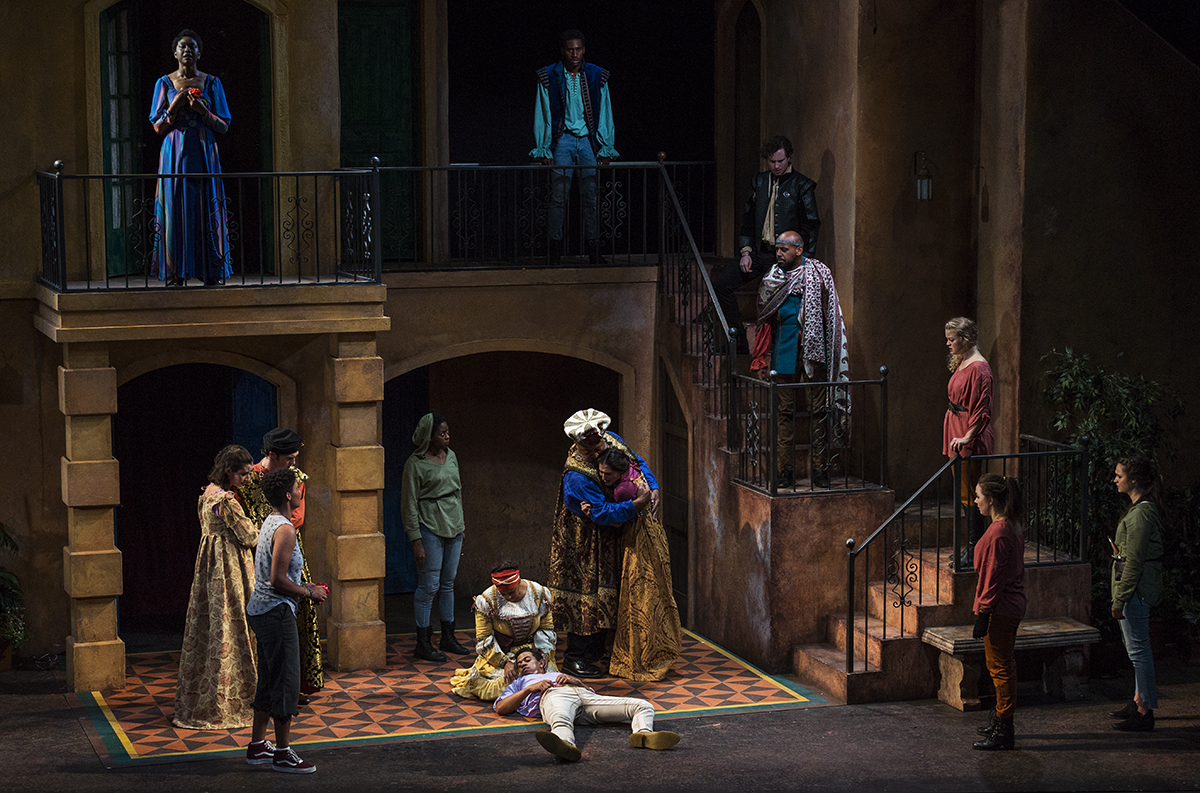Whether or not Romeo and Juliet is your favorite Shakespeare play, it’s certainly one most people know, a tragedy of young love and soaring poetry crushed by a macho society and parents who’ve forgotten they were ever young.
Rest assured that the current Chautauqua Theater Company production, no matter how unusual, is still the play we learned in school. And not only is this production spoken with intelligence and clarity, but the fights are fabulous! Kudos to CTC Artistic Director Andrew Borba and Tom Schall, text coach and fight director.
But Romeo & Juliet is more than poetry, two lovers and bloodshed. Every Shakespeare play contains several plays, the question being which is emphasized. Hamlet, for example, is a political drama, a noir murder mystery, a perverse family tragedy and an existential debate on life and death.
The range of options isn’t as great with R&J, but the current production just a few hours north at Canada’s Stratford Festival sees it as a drama of civic enmity and slaughter, in which these two young lovers are collateral damage, hardly the overwhelming focus at all.
There are other options beyond which story to tell. Call them innovation vs. convention. On the whole, convention was routed long ago. Take time and place: We’re used to seeing As You Like It set in the 1960s or The Tempest on a Caribbean island. Or ethnicity and color: The varieties of color-blind casting long ago won out. Even gender: Women have been playing men’s roles for more than a century, as if in compensation for men having played women’s roles when the plays were young.
Given so many alternatives, a director has to seize the reins, to decide which play to emphasize, when and where to set the story, what lines to prune and how to handle a zillion small details, like all the sex jokes (here, most are downplayed). I expect the decisions made by director Dawn Monique Williams will appeal to many and not to some.
The two rules that should obtain are clarity and determinacy. Is it clear to the audience when the ethnicity, for example, belongs to the actor or the character? And once this is established, does the production play fair and not upset expectation?
Frankly, this R&J isn’t always clear or stable. That can frustrate the audience’s imaginative participation, which is, after all, the main thing. On the other hand, it can be fun to untangle. I wish I were in a discussion group where we could argue it out.
The larger setting is clear: Verona. Andrea Bechert’s set is realistic, two house fronts, flights of stairs and greenery, such as you’d see any time from the 17th century to today. But it tries to be both specific and generic. So it’s often unclear whether a given scene is inside or outside, and the staircase that is obviously not there during the balcony scene — or why wouldn’t Romeo use it? — suddenly is, when he does. Better lighting would help.
However, time is more a matter of dress than set. Courtney Flores’ costumes run from floppy Renaissance hats and gowns to lots of jeans. The young wear earphones and the weapons are both swords and pocket knives.
As the play opens, a contemporary crowd is milling about like modern tourists. Then Benvolio delivers the prologue and we’re underway. You may feel you’ve stumbled on a performance of West Side Story. This indeterminacy is obviously intentional, suggesting that we haven’t really improved on the coercive patriarchy of four centuries ago.
The characters are played by actors of varying colors, but this is a clearly color-blind casting, where color is independent of character identity (although we might get an argument in our discussion).
Gender is a harder case. A number of women play male roles — desirable both because there are so few women in Shakespeare’s plays and in order to use more members of this young, pre-professional company.
Or are these male roles? Have they become women? Take Benvolio, or is it Benvolia (the very excellent Jules Latimer, a woman)? I understood Benvolio was a man, until I think I heard him called Benvolia. And then s/he is clearly surprised to be kissed by a hyper Mercutio, a character often portrayed as gay, although perhaps not so here. What does this say about Benvolio/a’s gender?
There are also the women who play the young men who accompany Romeo and friends to the Capulet ball, but then seem to turn into women once the dancing begins. Mercutio seems to pursue some of these — but as men or women? Perhaps all this sexual indeterminacy is intentional, maybe even a comment on sexuality in general or Shakespeare’s specifically. Still, I found the mixed signals destabilizing.
But even while challenged by these directorial inventions, the Chautauqua audience will see a competent rendition of the story.
Given the youth of the company, mainly recent graduates of leading actor training programs, it’s an advantage that R&J itself has such an emphasis on youth: It’s less about Montagues vs. Capulets than young vs. old.
To play the adult antagonists, the guest actors are Nafeesa Monroe (a satisfyingly blabbermouth, warm-hearted Nurse), Keith Randolph Smith (explosive as Juliet’s father, who turns out to be more than a genial guy in a funny hat) and Manu Narayan (a fine, sensitively drawn Father Laurence).
Siddiq Saunderson is an athletic, explosive Romeo, as you’d expect of an impulsive young man who switches love objects on a dime, and Adrianna Mitchell is an earnest, well-spoken Juliet — maybe more well-spoken than transported by love. I can’t say they broke my heart, but perhaps that’s me.
Among the others, the standout is Lavour Addison’s Mercutio. He is so intense, so mercurial (duh!), that there would be differences of opinion in our discussion group, but I welcomed his every scene. And Ms. Latimer handles Benvolio with unfailing presence and sympathy.
So what will you make of this huge undertaking?
The company publicity says the play dramatizes love as “redemptive,” but with all those bodies at the end and the suddenly repentant fathers trying to make up for the past by building expensive statues, it doesn’t feel redemptive to me. Delusional, maybe. Add that to the agenda for our discussion.
Christopher Rawson is the senior theater critic of the Pittsburgh Post-Gazette. A former chair of the American Theatre Critics Association, he has since 1968 been on the English faculty at the University of Pittsburgh, where he regularly teaches Shakespeare and August Wilson.





